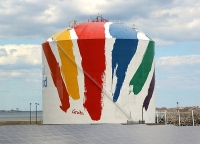Rainbow of Terror: how a government program to track suspicious activities snared an unsuspecting photographer
posted Wednesday, August 6, 2014 at 4:08 PM EDT

Photographer James Prigoff is renowned for his photographs of public art. He has authored several books of photographs of public artworks, lectures at universities on the topic and has exhibited his photographs at the Smithsonian. In 2004 he went to Boston and spent some time photographing that city’s public art projects. Several months after returning home to Sacramento, the 86-year-old photographer was visited by the FBI. Two agents came to his home and questioned him about his activities in Boston. They held in their hands a report that was distributed nationwide, which identified him as a suspicious person with a potential connection to terrorism.
The activity that led to the report? Photographing public artwork on a trip to Boston. Prigoff photographed the “Rainbow Swash,” a public artwork created in 1971 by Sister Mary Corita Kent (1918-1986). Sister Mary's stylized rainbow of colors transform a 140 foot tall gas tank into a striking work of public art. The "Rainbow Swash" -- as it is known to locals -- is visible to thousands of commuters on Boston’s Southeast Expressway and has been photographed hundreds of thousands of times.

Prigoff recalled that, upon arriving at the tank, "I was confronted by two security guards who came through their gate and told me I could not approach because the tank was on private property. I pointed out that I, being well outside the fenced area, was not on private property – but they insisted I leave. If one goes to Wikipedia there are number of excellent close-up shots for the entire world to see."
In response to this and several other cases, on July 10th, 2014, the ACLU filed a lawsuit against the federal government on behalf of Prigoff and four others, challenging the legality of the Suspicious Activity Reporting (SAR) program. In a statement to the ACLU, Prigoff noted:
“All I was doing was taking pictures in a public place, and now I’m apparently in a government terrorism database for decades,” Prigoff says, “This is supposed to be a free country, where the government isn’t supposed to be tracking you if you’re not doing anything wrong. I lived through the McCarthy era, and I know how false accusations, surveillance, and keeping files on innocent people can destroy careers and lives. I am deeply troubled that the SAR program may be recreating that same climate of false accusation and fear today.”
The problem is one of Kafka-esque dimensions. It is not the activity itself that matters but whether an anonymous SAR analyst believes the activity meets the undisclosed standards of the secret program, in which case they submit a report to national databases where it can remain for up to 30 years.

As a working photographer it makes me a little paranoid to know that photographing something as public as a gas tank painted with rainbow colors could put me on some kind of 'watch list.'
Comments welcome below...
Source: ACLU